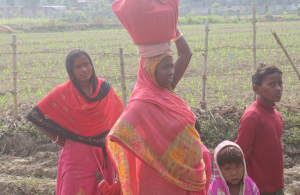TAD NewsDesk, New Delhi/Patna: On the intervening night of 26 and 27th November, farmers from Punjab decided to camp on the National Highway 44 in the middle of Haryana, forcing the nation to shift its gaze towards farmers who had been sitting on protest for more than six months in Punjab.
The protests began when the central cabinet approved ordinances to change the way farming has been done for years. Later, the bills were bulldozed in the parliament with a voice vote. The three bills, which later became acts with the President’s assent, are:
- Farmers Produce Trade and Commerce (Promotion and Facilitation) Ordinance, 2020.
- Farmers (Empowerment and Protection) Agreement on Price Assurance and Farm Services Ordinance, 2020.
- Essential Commodities (Amendment) Ordinance.
When one speaks to protesting farmers, one state’s name features endlessly, Bihar.
Even as support for the movement pours in from all corners of the world, it is imperative to read between the (head)lines and determine, based on the case study of another state where a similar bill was passed way back in 2006, how much are these ordinances going to affect the farmers of this nation, and how.

The effort to abolish the Mandi system in Bihar has been portrayed as an experiment gone wrong. Bihar was the first state in India to abolish the mandi system and invite private players to the market. Nitish Kumar’s government brought the APMC act in 2005, which killed the mandi system completely. 14 years down the line,
it doesn’t set a propitious ground for the rest of the country.
The farmers in Bihar feel unheard, unsatisfied, and largely unnoticed. So much so that they don’t even have rudimentary facilities to store, irrigate and protect their fields from natural calamities. “There is no connection between the farmers in their fields and government policies,” says Rajender Nishadh, a farmer from Begusarai. He adds, “The mandi system was anyway slowly killed before the act was abolished. Even after abolishing, middlemen have found ways to sell our grain in the markets.”

Deepak Kumar owns 30 Bighas of land in Maniyappan village of Begusarai district. Speaking about the core of farmer’s issues, he says, “The problem is more infrastructural and needs to be understood at a grass-root level. The main crops here are wheat, maize, and potatoes. We don’t have a mill nearby and have to travel 40-45 km away. We don’t have irrigation facilities. After the act was abolished, the situation remained the same. We still receive only the bare minimum for the crops”.
Kumar further explains that the yield is sold in two mediums, the Vyapaar manuals (Trade Board) and the PACS ( Primary Agriculture Credit Society), “I want to ask just one question, the Minimum Support Price for the wheat per quintal is Rs 1,950. How much did the government purchase from us? This year the government’s wheat requirement came in May, and the farmers had harvested it many months ago. Farmers get desperate and sell it to the private companies at prices much lower than the one set by the government”, he said.

Farmers have sold their produce for an amount as low as Rs 800 per quintal, less than half of the MSP.
The worst affected are the landless farmers, known as Batedaars in Bihar. Samicharan Bhim works on a contractual basis on one-hectare land. “I am investing around 14000 on the field in which the major expenses are manure and fertilizers. Our family of five works day and night, seven days a week. We get a daily wage of Rs 150 and 1/16th share of grain produced.”
Not getting enough money for their crop isn’t the only issue bothering the farmers of Begusarai. The region is infamous for its floods. The landless farmers end up with nothing if their produce is washed away in floods, and the problems do not end there.
Once the floodwater subsides, there are droughts to be tackled. According to the farmers, no relief package reaches them. Bhim asks, “The policies are just for the rich to get richer and the poor to get poorer. Where should we go? What employment opportunities do we have? Who will discuss that?”

Around 94 percent of the Bihar farmers are Batedaars, and none of them receive benefits from any of the government’s schemes. “We are not considered farmers by most of the schemes. Does the government even think about the poor?” Rajender asks.
Economist DM Diwakar breaks it down in an article written in the magazine DownToEarth, “The Modi government says the new farm bills won’t adversely impact the farming community. Given the logic, the financial condition of 94 percent of farmers in Bihar who didn’t go to mandis or were not covered under minimum support price (MSP) should have improved in the past 14 years. But their condition has deteriorated.”
The small farmers are unable to recover what they invested. They don’t get credit from authorized banks and end up taking loans from private entities. When it comes to paying back, they don’t have any option but to sell their land and migrate to other states to work as laborers.
Another question that is often gets thrown around is that why were farmers in Bihar silent? According to locals, unlike Punjab, Haryana, and Uttar Pradesh, the Bihar farmers are not united; hence their problems are not even a matter of discussion in the election campaigns. “We don’t have a united voice. We are too divided by caste and politics. There is nobody who represents us. But there should be a fight for the benefit of the farmers, an unbiased and clear fight,” Nishadh said.










